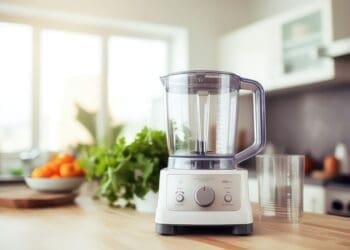The Aroma ice cream maker celebrates a rich heritage that stretches back to the nineteenth-century America, a time when the first hand-cranked churner revolutionized homemade ice cream.
Store shelves might be stocked with countless ice cream flavors, but creating your own frozen delights at home offers a unique experience.
This traditional 4-quart ice cream maker blends nostalgic charm with modern convenience. The sturdy fir wood bucket houses both a classic hand crank and an electric motor that makes the process easier.
The price tag reads $88.99, marked down from $139.99, making this kitchen companion an affordable way to create delicious frozen treats your family will love.
Let me share my hands-on experience with the Aroma ice cream maker and help you determine whether this appliance belongs in your kitchen arsenal.
What You Get With The Aroma Ice Cream Maker

The Aroma ice cream maker combines old-world craftsmanship with modern convenience. A chemical smell greets you when you first open the package, but it goes away within 24 hours.
Unboxing Experience and First Impressions
Your package comes with a detailed instruction manual that includes classic ice cream recipes to start your frozen treat adventure. The fir wood bucket looks rustic but shows a few minor flaws in its finish. Users have pointed out some scratches and what seems like rushed staining work.
Key Components and Build Quality
The ice cream maker has ten main parts:
- Electric motor with power cord
- Traditional die-cast hand crank
- Sturdy wooden bucket with latching mechanism
- Aluminum mixing canister
- Canister lid with cap
- Plastic stirrer
- Dasher for churning
The aluminum canister helps freeze contents faster, and the wooden bucket’s handles make it easy to carry around. You can switch between motorized churning or old-fashioned hand-cranking based on what you prefer.
Technical Specifications That Matter
This machine offers a generous 4-quart (3.785 liters) capacity that works great for family gatherings or making multiple batches. The churning takes about 15-25 minutes, based on room temperature. The motor stops by itself once your ice cream reaches the right consistency.
You’ll need to prep the machine before its first use. The bucket needs water to let the wood expand, which stops ice and salt from leaking during use. Make sure to freeze the mixing canister and dasher beforehand for best results.
The unit’s safety features include a polarized plug and a shorter power cord that reduces tangling risks. While you can’t put it in the dishwasher, the removable parts are easy to clean by hand.
This ice cream maker’s toughness really stands out – many users say it lasts for decades. Some machines from the 1980s still work perfectly with yearly use. The machine’s long life and its ability to make different frozen treats, including low-fat and sugar-free options, shows what a great value it is.
Real Testing Results: 30 Days of Ice Cream Making

My month of testing helped me find what the Aroma ice cream maker could really do with different recipes and methods.
Vanilla Ice Cream Test Results
The vanilla ice cream test showed that a well-churned base gets so thick you need to scrape it from the bowl. The machine needed about 40 minutes to get the perfect consistency. The mixture had to stay in the freezer for 2-4 hours after that to reach the right texture for serving.
Chocolate Ice Cream Performance
The chocolate ice cream test showed how versatile this machine could be. I mixed half and half with cocoa powder, sugar, and vanilla extract using the maker’s recipe. The motor kept its speed steady for the whole 40-minute churning time. Adding vanilla extract halfway through at the 20-minute mark worked better than adding it at the start because alcohol makes freezing harder.
Fruit-Based Ice Cream Challenges
Making ice cream with fruit came with its own set of challenges. The best results came when I cut the fruit puree amount by half to stop ice crystals from forming. The machine worked best with very ripe fruits since cold makes flavors milder. The fat content needed careful adjustment – 8-15% for gelato-style and 15-25% for traditional ice cream.
Motor Performance Under Load
The motor worked reliably with every recipe I tried. Each batch needed 1-2 medium bags of ice layered with rock salt up to the drainage hole. I added more ice and salt when the level dropped 2-3 inches to keep the freezing temperature right. The motor stopped by itself when the ice cream was ready, which prevented over-churning.
The machine worked best when I stuck to one speed setting throughout the process. Changing from soft to hard settings midway could put too much strain on the motor. When recipes needed cooking first, letting the mixture cool overnight helped the motor work better and gave the mix room to expand.
Maintenance and Care Guide

The Aroma ice cream maker will perform at its best and last longer with proper maintenance. I’ve learned the best ways to keep this classic machine running smoothly through years of use.
Cleaning After Each Use
The machine needs to cool down after I unplug it from churning. I take apart all the components and start cleaning. My first step is washing the cover, mixing paddle, and freezer canister with warm soapy water and a soft sponge or dishcloth.
The wooden bucket needs a good wipe with a soapy sponge to remove any salt-water residue. This is a vital step since salt can damage metal parts over time. I make sure everything is completely dry – the freezer canister especially needs attention because freezing it wet can harm the unit.
The motor base needs special care. A quick wipe with a slightly damp cloth removes dust. You should never put the motor base in water or clean it with anything abrasive.
Storage Tips for Longevity
Your ice cream maker’s life will substantially improve with proper storage. Since homemade ice cream lacks preservatives, it usually stays fresh about a week. I keep the finished ice cream in airtight containers and press plastic wrap right on top to stop ice crystals and freezer burn.
The freezer canister must be bone dry before storage. The aluminum mixing canister helps freeze things faster, so I store it in my freezer’s back where the temperature stays steady.
My experience shows that heat-sanitizing dishwashers can diminish the efficacy of the cylinder’s gel lining. That’s why I never put any parts in the dishwasher. Hand washing works best, and I keep all parts separate in a cool, dry spot.
A steady freezer temperature of 0°F (-18°C) prevents fluctuations that could affect your machine’s performance and ice cream quality. These careful maintenance steps have helped many users enjoy their Aroma ice cream makers for decades.
Cost Analysis and Value

The switch to homemade ice cream brings up questions about cost savings. My detailed financial analysis comes from testing the Aroma ice cream maker thoroughly.
Original Investment vs Store-Bought Ice Cream
The Aroma ice cream maker’s current price of $88.99 offers great value compared to its original price of $139.99. A pint of premium store-bought ice cream costs $4.00 to $10.00. The same quantity of homemade ice cream costs just $2.00 to $3.00.
Operating Costs Breakdown
Making ice cream at home requires these expenses:
- Simple ingredients (milk, cream, sugar): $2.00-$3.00 per liter
- Electricity costs remain low thanks to the motor’s design
- Rock salt and ice: about $0.50 per batch
- Extra flavors and mix-ins: recipe dependent
Premium ice cream shops charge $2.00 to $8.00 per serving. Mid-range store brands cost $3.00 to $4.00 per liter. These prices make homemade ice cream look more appealing.
Long-Term Savings Potential
Regular use reveals the money-saving benefits quickly. A family buying $6.00 pints of premium ice cream twice monthly spends about $144 yearly. Making this amount at home costs roughly $72 per year, not counting the machine’s cost.
The Aroma ice cream maker’s durability adds to its value. Users report the machine works well for decades, which spreads the upfront cost over many years. On top of that, it makes various frozen treats, including low-fat options and sorbets that often cost more at stores.
The value goes beyond just saving money when you factor in customization options and control over ingredients. Homemade premium ice cream costs about $0.52 per serving. Similar store-bought varieties can cost three times as much. New users might spend more while learning, but experienced makers spend less per serving than store-bought options.
Conclusion
I’ve put this Aroma ice cream maker through its paces, using it every day. It’s an excellent investment for any home kitchen. I was skeptical about its old-school design at first, but this machine proved its worth with reliable performance and amazing durability.
The numbers tell a clear story – you’ll spend about half as much making ice cream at home compared to buying premium brands. On top of that, knowing how to control ingredients and play with flavors makes this machine better than just grabbing something from the store.
This ice cream maker shines by combining vintage charm with modern practicality. I can switch between electric and hand-cranked churning modes. The rock-solid build quality suggests this machine will last for years.
The machine has some rough edges in its finish and a strange chemical smell when new, but these small issues don’t take away from its strengths. Easy maintenance and simple controls make this perfect for everyday use.
My month of testing shows this ice cream maker delivers on its promise – delicious homemade frozen treats that cost way less than store-bought ones. The $88.99 price tag is definitely worth it, especially since older models from decades ago still work perfectly today.
FAQs
Q1. How long does homemade ice cream last?
Homemade ice cream typically lasts about one week when stored properly. To maintain its quality, store it in airtight containers and press plastic wrap directly onto the surface to prevent ice crystals and freezer burn.
Q2. Is making ice cream at home cost-effective?
Yes, making ice cream at home can be cost-effective. Homemade ice cream costs roughly half as much as store-bought premium varieties, with an average cost of $2.00 to $3.00 per pint compared to $4.00 to $10.00 for store-bought premium ice cream.
Q3. How long does it take to make ice cream with the Aroma Ice Cream Maker?
The churning process with the Aroma Ice Cream Maker typically takes 15-25 minutes, depending on the ambient temperature. After churning, the ice cream should be placed in the freezer for an additional 2-4 hours to reach the optimal serving texture.
Q4. Can the Aroma Ice Cream Maker be used to make different types of frozen desserts?
Yes, the Aroma Ice Cream Maker is versatile and can be used to create various frozen treats, including traditional ice cream, low-fat options, and sorbets. It can handle different recipes and ingredient combinations.
Q5. How should I clean and maintain the Aroma Ice Cream Maker?
After each use, disassemble all components and wash them with warm soapy water. The wooden bucket should be cleaned with a soapy sponge to remove salt residue. Dry all parts thoroughly, especially the freezer canister. The motor base should only be wiped with a slightly damp cloth. Avoid using a dishwasher for any components to maintain their longevity.





















































